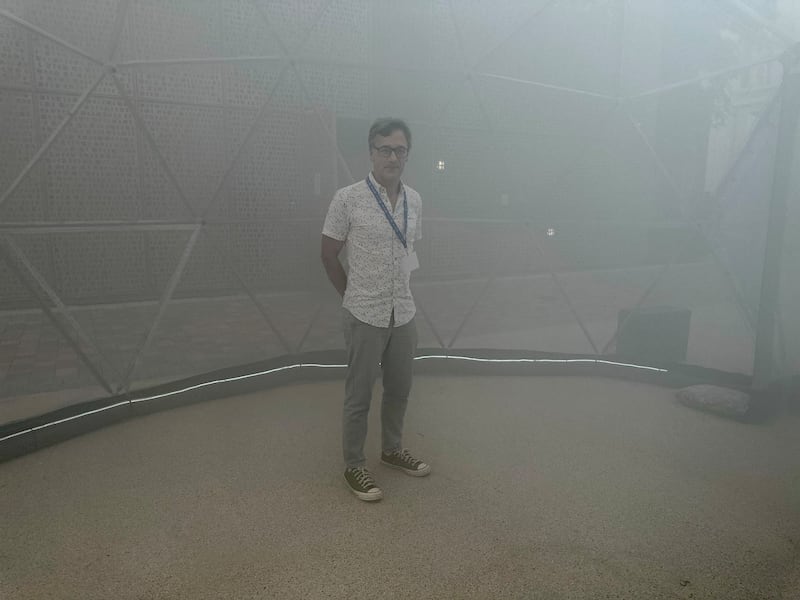As world leaders huddled inside various rooms at the COP28 to discuss ways to tackle climate change, visitors were offered an unconventional and compelling exhibit in another corner of the summit venue in Dubai.
Picture stepping into a world where the air you breathe tells a story of cities choked by pollution, lives cut short, and the urgent need for change.
“Pollution Pods” is a sensory journey in four interconnected plastic domes with the inside mimicking the air quality of the metropolises of London, New Delhi, and Beijing.
“What I’m trying to do is safely immerse people in the actual experience of air pollution. I don’t think reading about it is the same as experiencing it,” artist Michael Pinsky told Radio Free Asia on Tuesday.
He said he wanted visitors, especially the policy-making delegates, to be “quite shocked.”
“Shock is a good motivation for changing patterns of behavior,” he added.

Pasinee Wongsaa, a Thai visitor, said she was shocked, even though she lived through smog this past winter.
Northern Thailand, Laos and Myanmar experienced one of the worst smogs ever earlier this year, mainly due to crop burning and forest fires.
“I guess I had forgotten how bad it was,” she said. “Inside the pod, especially Beijing, it was extremely polluted and brought back memories.”
Globally, air pollution is the “single biggest environmental threat to human health,” according to the World Health Organization.
Some 1,000 newborns die every day because the first breaths they take are so toxic, the Clean Air Fund, a global organization working on pollution, which supported the art installation, said.
Burning of fossil fuels, like coal, oil, and gas, is a primary reason for air pollution. Such fuels emit harmful pollutants that contribute to global warming, intensify extreme weather events, and damage human health.
The topic was the most contentious one at the COP28 climate summit, as world leaders struggled to agree on phasing out fossil fuels, with meetings extending until 3 a.m. for two days. Finally, they agreed on what climate activists have called a weak “incremental” deal.
Majority air pollution death in China, India
The COP28 exhibition comes as new study findings revealed that China bears the heaviest burden of air pollution-related deaths, with an alarming toll of 2.44 million lives lost annually.
India closely follows with 2.18 million fatalities. Notably, both countries are the world’s most populous nations, and top consumers of fossil fuels and producers of carbon emissions.
An estimated 8.3 million lives are lost annually to the scourge of air pollution globally, according to the study published in the British Medical Journal on Nov. 29.
Among these casualties, the burning of fossil fuels in industry, power generation, and transportation stands as the chief culprit, responsible for over 5 million, or nearly two-thirds, of these deaths worldwide.
Most deaths were linked to ischaemic heart disease, stroke, lung disease, diabetes, and more.

The study suggests that the impact of phasing out fossil fuels, such as coal, oil and natural gas, on global mortality could be more significant than previously anticipated.
It said that if fossil fuels were phased out across Asia, 80 to 85% of preventable deaths from human-caused air pollution could be avoided.
“Air pollution in China, even though it has decreased in the past decade, to a large degree depends on fossil fuel use, which has increased in the same period,” lead author Jos Lelieveld, director of the atmospheric chemistry department at the Max Planck Institute for Chemistry in Germany, was quoted as saying in the South China Morning Post.
“The population is aging, which is extending the period of exposure, leading to chronic diseases, which especially affect the elderly.”
Researchers also emphasized that phasing out fossil fuels would result in reduced disease burdens and healthcare system relief worldwide.
The benefit of exploitation without the consequences
Pinsky, based in London, said he thought of the idea after traveling to Norway, which has some of the cleanest environments, and other parts of the world with the dirtiest air.
For many, especially in the global North, this air quality is unbelievable, said Pinksy, who has taken the exhibit to different parts of the world.
“They don’t get it because when I showed this to Norway, they were really, really shocked. In fact, they couldn’t believe it. They would say, ‘Surely it’s not like this in New Delhi’,” he said.
“It’s not just for five minutes, people live in this, 24 hours a day. And that is almost impossible for them to comprehend.”

Pinsky crafted the immersive experience inside the pods by replicating the presence of ozone, particulate matter, nitrogen dioxide, sulfur dioxide, and carbon monoxide found in these cities.
London’s distinct smell mimicked the city’s high nitrogen oxide due to car exhaust. Delhi was smoggy, felt like pollution from crop burning and was very hot. Due to vehicles, industries and coal use, Beijing pods had very low visibility and a strong smell of bad air.
A fourth pod showcased innovative technologies to clean up the air and more information about the pollution levels in every major city worldwide.
Pinsky said the Western cities with clean air are buying cheap products from these cities with few water and air pollution regulations and even less enforcement.
“So, they enjoy the benefits of that exploitation but don’t suffer the consequences. And the idea of the pods is to show everything’s connected. Your lifestyle does impact on people in other parts of the world,” he said.
For the first time, COP28 hosted Health Day, as more than 50 health ministers joined their climate counterparts in the first week of the summit, which also adopted the Declaration of Climate and Health.
Some 141 countries have endorsed the pledge to protect health from climate impacts and strengthen healthcare systems.
Neither India and China have signed yet.
Edited by Mike Firn and Taejun Kang.
